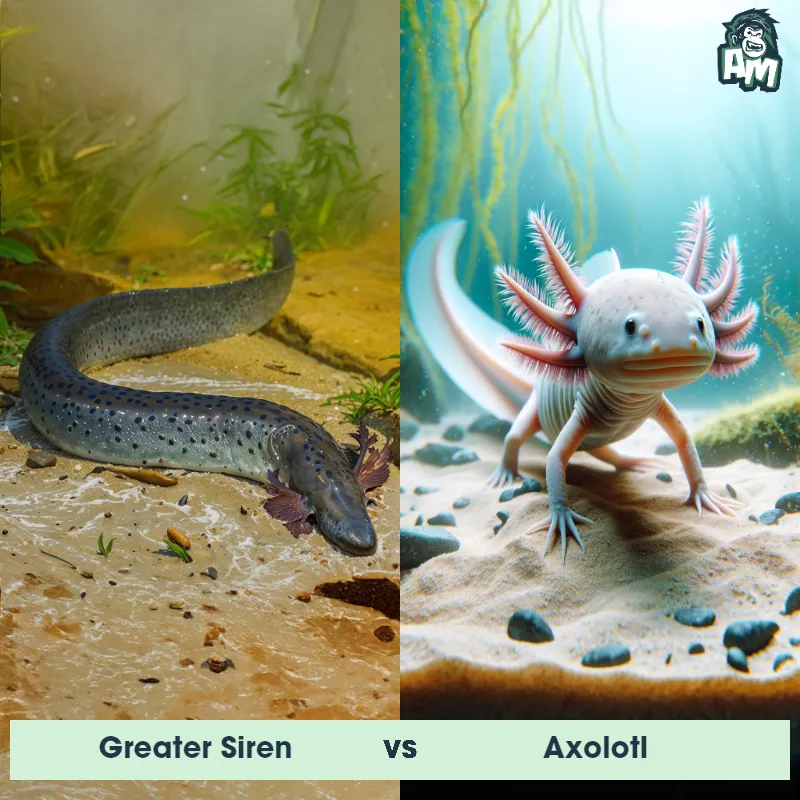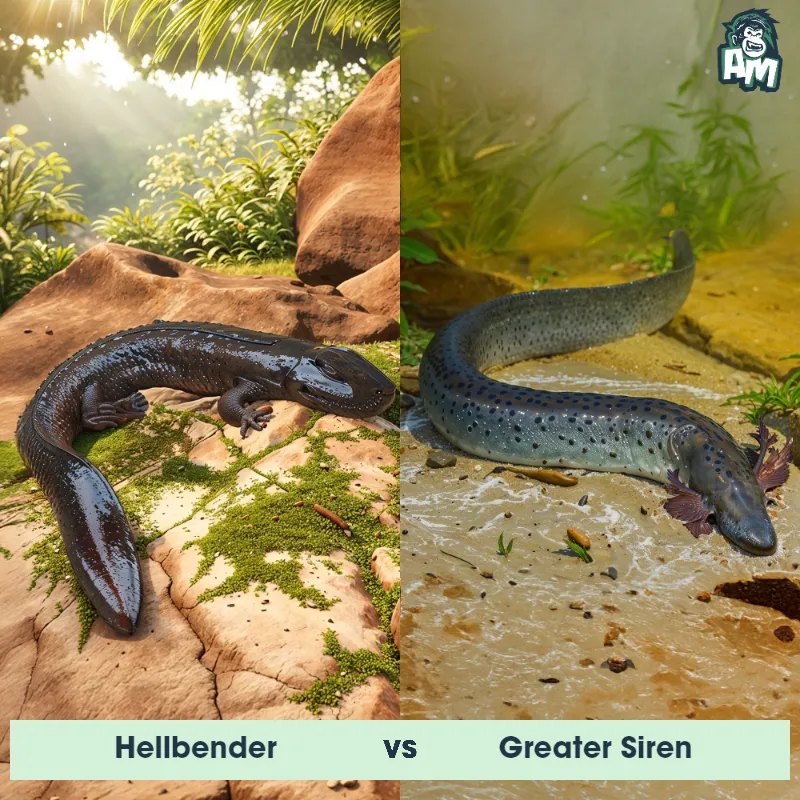The Greater Siren
The Greater Siren, also known as the American Eel, is a large aquatic salamander found in the southeastern United States. It can grow up to three feet long and has a long, slender body with external gills and small forelimbs. Its coloration ranges from pale gray to dark brown, helping it blend in with its muddy habitat.

| Greater Siren | |
|---|---|
| Size | Over 3 feet (91.4 cm) |
| Weight | Up to 5 pounds (2.3 kg) |
| Speed | 2mph (3.22 km/h) |
| Key Strength | Agility and speed in water |
| Biggest Weakness | Vulnerability on land due to lack of hind limbs |
| Scientific Name | Siren lacertina |
| Family | Sirenidae |
| Habitat | Freshwater ponds, swamps, and marshes |
| Geography | Southeastern United States |
| Diet | Carnivorous, feeding on aquatic invertebrates, small fish, and amphibians |
| Lifespan | 11 years - 14 years |

The Greater Siren
The Greater Siren, also known as the American Eel, is a large aquatic salamander found in the southeastern United States. It can grow up to three feet long and has a long, slender body with external gills and small forelimbs. Its coloration ranges from pale gray to dark brown, helping it blend in with its muddy habitat.
Fun Fact: The Greater Siren has the ability to produce a loud clicking noise when threatened, scaring off potential predators with its surprising vocalization.
| Greater Siren | |
|---|---|
| Size | Over 3 feet (91.4 cm) |
| Weight | Up to 5 pounds (2.3 kg) |
| Speed | 2mph (3.22 km/h) |
| Key Strength | Agility and speed in water |
| Biggest Weakness | Vulnerability on land due to lack of hind limbs |
| Scientific Name | Siren lacertina |
| Family | Sirenidae |
| Habitat | Freshwater ponds, swamps, and marshes |
| Geography | Southeastern United States |
| Diet | Carnivorous, feeding on aquatic invertebrates, small fish, and amphibians |
| Lifespan | 11 years - 14 years |
Greater Siren Matchups
We use AI to simulate matchups between the Greater Siren and other animals. Our simulation considers size, strength, and natural predatory behaviors to determine the most likely outcome.

Can't find the Matchup you want?
Create Your Own MatchupGreater Siren: Diet, Predators, Aggression, and Defensive Behaviors
What do Greater Sirens eat?
Greater Sirens are primarily carnivorous and feed on a variety of prey such as small fish, aquatic invertebrates, amphibians, and even other smaller aquatic vertebrates. They use their sharp teeth to grasp and consume their prey.
Do Greater Sirens have any predators?
While Greater Sirens are large predators themselves, they can still fall prey to larger mammals such as raccoons, otters, and larger fish species like bass or catfish. Additionally, birds of prey like herons or eagles may also prey on juvenile Greater Sirens.
Are Greater Sirens aggressive?
Greater Sirens are generally not aggressive towards humans or other animals unless they feel threatened or provoked. They are more likely to try and flee from potential threats rather than engage in aggressive behavior.
Do Greater Sirens fight?
Greater Sirens may engage in territorial disputes or competition for food resources with other individuals in their habitat, which can lead to fighting. They are known to use their muscular bodies to push and shove one another during these conflicts.
How do Greater Sirens defend themselves?
When threatened, Greater Sirens rely on their ability to secrete a sticky, slime-like substance from their skin that makes them difficult for predators to grasp. This slimy coating also acts as a protective barrier against parasites and helps to prevent dehydration when out of water.
What is the Greater Siren's biggest weakness in a fight?
Despite their size and strength, one of the Greater Siren's biggest weaknesses in a fight is their vulnerability due to their relatively soft and unprotected skin. This makes them susceptible to injuries from predators or rival individuals during confrontations.
Fun Fact: Despite their appearance, Greater Sirens are not actually eels; they belong to the family Sirenidae within the order Caudata, which also includes newts and salamanders.
Fun Fact: Greater Sirens are capable of surviving out of water for extended periods by burrowing into moist soil or mud, allowing them to endure dry periods in their natural habitat.












